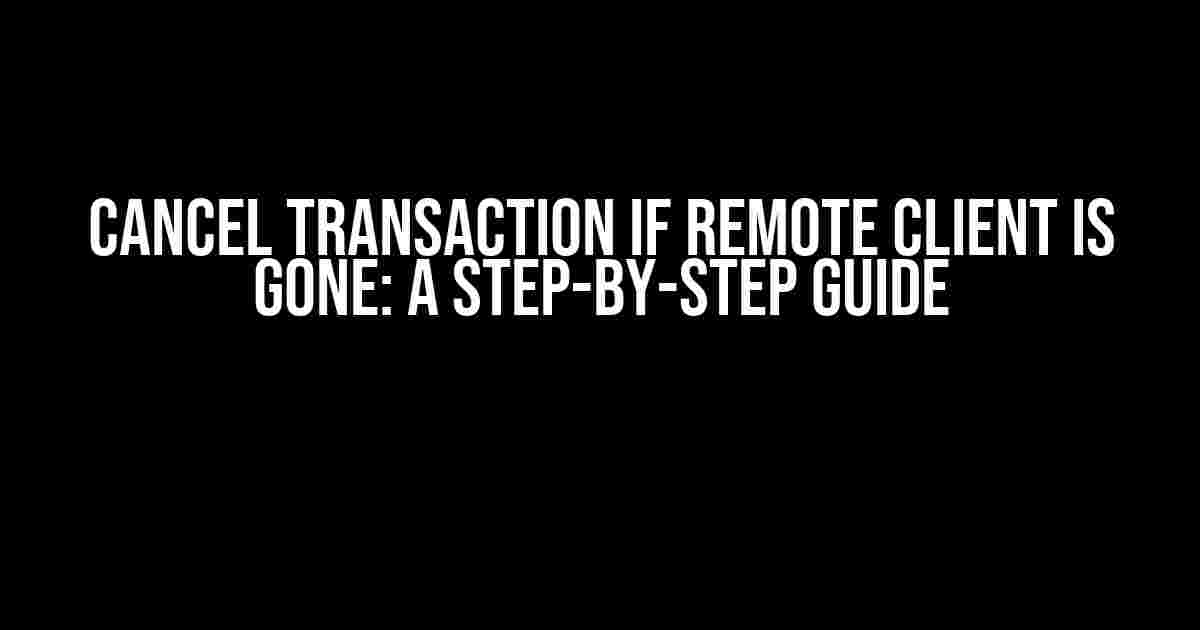Have you ever encountered a situation where you’re stuck with a pending transaction, and the remote client has vanished into thin air? Well, you’re not alone! This frustrating scenario is more common than you think, especially in today’s fast-paced digital landscape. But fear not, dear reader, for we’ve got you covered. In this comprehensive guide, we’ll walk you through the process of canceling a transaction if the remote client is gone, ensuring you’re protected and empowered.
Understanding the Scenario
Before we dive into the nitty-gritty, let’s set the stage. Imagine you’re a service provider, and you’ve initiated a transaction with a remote client. This could be a payment, data transfer, or any other type of exchange. Suddenly, the client disappears, leaving you with a pending transaction and a whole lot of uncertainty.
Why Cancel the Transaction?
Cancelling the transaction is crucial in this scenario for several reasons:
- Security**: Leaving the transaction pending can pose a significant security risk, as it may leave your system or data vulnerable to unauthorized access.
- Resource Wastage**: A pending transaction can consume valuable resources, such as server capacity, memory, and bandwidth, which could be better utilized elsewhere.
- Financial Protection**: Cancelling the transaction can help prevent potential financial losses, especially if the client has no intention of completing the transaction.
Step-by-Step Instructions
Now that we’ve established the importance of cancelling the transaction, let’s move on to the step-by-step process:
Step 1: Identify the Transaction
First, you need to identify the transaction in question. This may involve:
- Checking your system logs for the transaction ID or reference number.
- Verifying the transaction details, such as the client’s IP address, username, or any other unique identifier.
Step 2: Determine the Client’s Status
Next, you need to determine the remote client’s status:
- Check if the client has gone offline or is no longer responding.
- Verify if the client’s account has been deactivated or suspended.
- Reach out to the client’s support team (if available) to confirm their status.
Step 3: Cancel the Transaction
Now that you’ve confirmed the client’s status, it’s time to cancel the transaction:
// Example code snippet in Python
import requests
transaction_id = "TX123456"
url = "https://api.example.com/transactions/" + transaction_id
response = requests.delete(url, headers={"Authorization": "Bearer YOUR_API_KEY"})
if response.status_code == 200:
print("Transaction cancelled successfully!")
else:
print("Error cancelling transaction:", response.text)
// Example code snippet in JavaScript (using Axios)
const axios = require('axios');
const transactionId = "TX123456";
const url = `https://api.example.com/transactions/${transactionId}`;
axios.delete(url, {
headers: {
'Authorization': 'Bearer YOUR_API_KEY'
}
})
.then(response => {
console.log('Transaction cancelled successfully!');
})
.catch(error => {
console.error('Error cancelling transaction:', error);
});
Step 4: Verify the Cancellation
After cancelling the transaction, verify that it has been successfully cancelled:
- Check the transaction status in your system logs or database.
- Verify that the resources allocated for the transaction have been released.
- Confirm that the client’s account has been updated to reflect the cancellation.
Best Practices and Considerations
In addition to the step-by-step process, keep the following best practices and considerations in mind:
| Best Practice | Consideration |
|---|---|
| Implement a timeout mechanism | Set a reasonable timeout period to automatically cancel transactions if the client doesn’t respond within a certain timeframe. |
| Use secure communication protocols | Ensure that all communication between your system and the remote client is encrypted and secure to prevent unauthorized access. |
| Maintain accurate system logs | Keep detailed system logs to facilitate easy identification and cancellation of transactions. |
| Develop a client notification system | Implement a system to notify clients of transaction cancellations, ensuring transparency and minimizing potential disputes. |
Conclusion
In conclusion, cancelling a transaction if the remote client is gone is a crucial step in maintaining the security, integrity, and efficiency of your system. By following the step-by-step instructions and best practices outlined in this guide, you’ll be well-equipped to handle such scenarios with confidence. Remember to stay vigilant and adapt to changing circumstances to ensure the continued success of your endeavors.
Frequently Asked Question
Got questions about canceling transactions when the remote client disappears? We’ve got answers!
What happens if the remote client suddenly goes offline during a transaction?
If the remote client disappears mid-transaction, our system is designed to automatically cancel the transaction to prevent any potential issues or losses. Your safety is our top priority!
How quickly does the system detect when a remote client is gone?
Our system is equipped with real-time monitoring, allowing us to detect when a remote client goes offline in a matter of seconds. This ensures that we can swiftly cancel the transaction and prevent any potential problems.
Will I be notified if a transaction is canceled due to a remote client disappearing?
Yes, you will receive a notification as soon as the transaction is canceled. This way, you’re always in the loop and can take the necessary steps to rectify the situation.
What if I’m unsure about what happened to the remote client?
Don’t worry! Our dedicated support team is here to help you investigate and resolve the issue. Just reach out to us, and we’ll work together to figure out what happened and find a solution.
Are there any additional measures I can take to prevent similar issues in the future?
Yes, there are several precautions you can take, such as regularly updating your software and firmware, using strong passwords, and being cautious when interacting with remote clients. We also recommend reviewing our security guidelines for additional tips and best practices.

